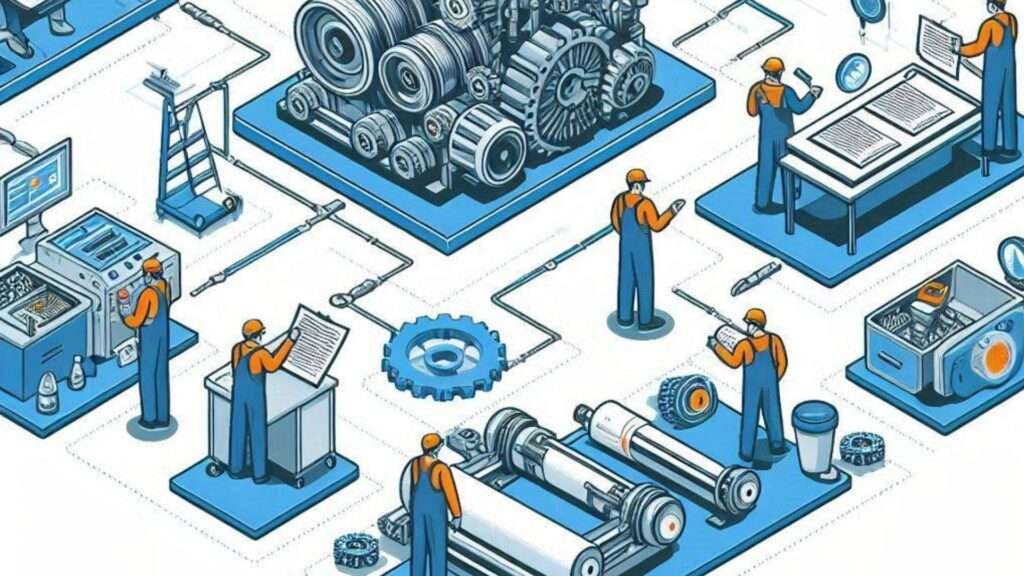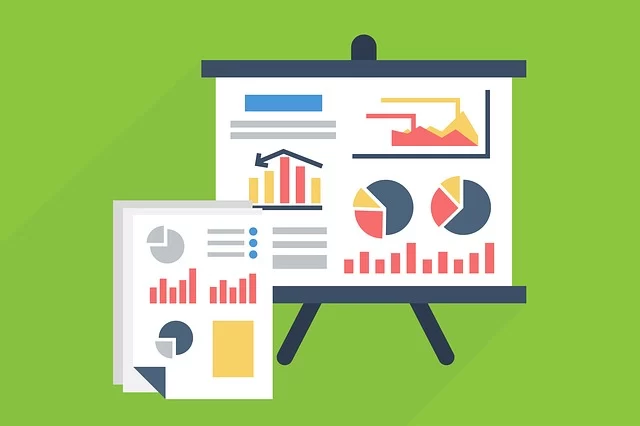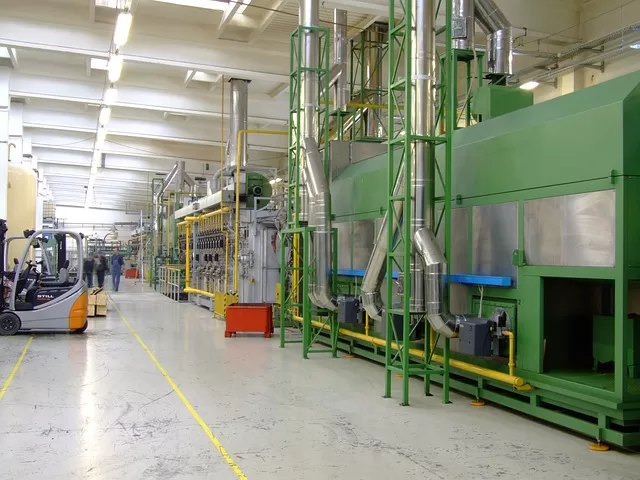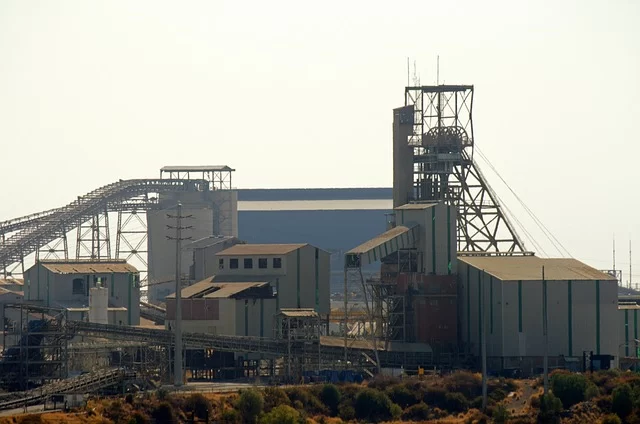Asset Management Accreditation Options For Your Company.
Effective asset management has become an essential component of a company’s success.
As businesses strive to maximise the value of their assets while minimising risks and optimising costs, the need for a standardised, globally recognised framework has never been greater for companies such as:
1. Utility Companies:
a. Electricity, Water, Gas and telecommunications utilities.
b. These all manage extensive infrastructure networks critical to public service.
2. Transportation and Logistics Companies:
a. Airlines, railways, shipping companies, and logistics providers.
b. They all rely heavily on vehicles, facilities, and complex distribution networks.
3. Manufacturing Companies:
a. Particularly those with high-value equipment and production lines.
b. Asset-intensive industries like automotive, aerospace, and heavy machinery.
4. Oil and Gas Companies:
a. Manage complex extraction, refining, and distribution assets.
b. Often operate globally with high-risk, high-value assets.
5. Mining Companies:
a. Operate expensive and specialized equipment in challenging environments.
b. Asset management crucial for safety and efficiency.
These types of organizations typically have:
1. High-value assets critical to their operations.
2. Complex asset ecosystems requiring sophisticated management.
3. Significant risks associated with asset failure.
4. Potential for substantial cost savings through optimized asset management.
5. Operations that span multiple locations or countries.
6. Statutory and Regulatory requirements related to asset performance and safety.
Enter ISO 55000, the international standard that has the ability to transform the way organizations approach asset management.
With this article I’ll be providing a comprehensive guide to understanding ISO 55000 and its impact on modern asset management practices.
I’ll delve into the intricacies of this standard, exploring its components, benefits, and the transformative effect it can have on your organization’s approach to managing assets.
Throughout this exploration, I’ll cover:
1. The evolution of asset management standards, from PAS 55 to ISO 55000.
2. A detailed breakdown of the ISO 55000 family of standards.
3. The certification process and its significance for businesses.
4. Key principles of effective asset management under ISO 55000.
5. The role of risk assessment and continuous improvement in asset management.
6. How ISO 55000 integrates with existing management systems.
7. The importance of professional certifications in asset management.
8. Real-world benefits of implementing ISO 55000-aligned practices.
Whether you’re a seasoned asset management professional or new to the field, this document will hopefully provide you with some valuable insights into how ISO 55000 is shaping the future of asset management.
My goal is to provide you with a reasonable understanding of why organizations worldwide often adopt the framework of this standard and how it can drive operational excellence, risk mitigation, and strategic decision-making.
As I navigate through the complexities of ISO 55000, I will endeavour to highlight practical takeaways and best practices that you can apply to your own asset management strategies.
By the end, you’ll be equipped with the desire to learn more and leverage ISO 55000 for enhanced asset performance, improved organizational efficiency, and a stronger competitive position in the global market.
Embark on this journey with me as I unravel the power of standardized asset management and discover how ISO 55000 can transform your approach to managing your organization’s most valuable resources.
The Three Parts of ISO 55000.
The ISO 55000 series is a comprehensive framework designed to help organizations implement effective asset management practices and gain international recognition.
It comprises of three key standards:
1) ISO 55000:2014.
2) ISO 55001:2014.
3) ISO 55002:2014.
This series provides a structured approach to asset management that aligns with broader international standards.
What is ISO 55000:2014?
This standard serves as the foundation, introducing essential asset management principles and terminology.
It establishes a common language and a conceptual framework that organizations can use to understand the value of asset management.
By defining terms and outlining the benefits, ISO 55000:2014 sets the stage for organizations to develop a coherent asset management strategy.
What is ISO 55001:2014?
This standard outlines the management system requirements necessary for establishing, implementing, maintaining, and improving an asset management system.
It specifies the criteria for an effective asset management framework, emphasizing the need for a systematic approach to managing assets throughout their lifecycle.
This standard requires organizations to have clear objectives, risk management strategies, and performance monitoring mechanisms in place.
By adhering to ISO 55001:2014, companies can ensure that their asset management practices are robust, consistent, and aligned with their overall business goals.
What is ISO 55002:2014?
This standard provides detailed application guidelines to support the implementation of the requirements set forth in ISO 55001:2014.
It offers practical advice and examples to help organizations tailor their asset management systems to their specific needs.
It is particularly valuable for translating high-level requirements into actionable steps, ensuring that the asset management system is both effective and efficient.
Realising The Benefits of the ISO 55000 series.
Aligning with other international standards such as ISO 9000, ISO 14000, and ISO 45000, the ISO 55000 series helps organizations achieve excellence in asset management.
By integrating these standards, companies can create a cohesive management system that enhances quality, environmental performance, and occupational health and safety.
This alignment matters, as it not only streamlines operations but also bolsters the organization’s reputation on the global stage, facilitating international recognition and competitiveness.
ISO 55000: Formal Certification Asset Management Standard.
ISO 55000 is an internationally recognized standard that provides a structured framework for effective asset management.
Achieving certification involves undergoing a rigorous, independent assessment to ensure compliance with the standard’s requirements.
This external evaluation is conducted by accredited certification bodies, which scrutinize the organization’s asset management practices, systems, and processes.
The objective is to verify that the company adheres to the high standards set by ISO 55000, ultimately ensuring the reliability, sustainability, and efficiency of its asset management operations.
The certification process for ISO 55000 can be both time-consuming and costly, typically varying based on the size and complexity of the organization seeking to be accredited.
Initial assessments may take several months, involving comprehensive audits and reviews.
Companies must invest in training, system improvements, and sometimes even new technology to meet the stringent criteria.
Despite these initial investments, I think most would agree that the long-term benefits often far outweigh the costs.
ISO 55000 certification demonstrates a company’s commitment to robust asset management practices, which can lead to enhanced operational performance, reduced risks, and increased return on assets.
One of the critical advantages of achieving ISO 55000 certification is the assurance it provides to stakeholders about your company’s dedication to maintaining high asset management standards.
This certification acts as a testament to the company’s strategic focus on asset optimization and lifecycle management.
It ensures that senior management is not only involved but also committed to the company’s future, fostering a culture of continuous improvement and accountability.
ISO 55000 certification can enhance a company’s reputation on the global stage, facilitating international recognition and credibility.
It communicates to potential clients, partners, and investors that the company possesses the expertise, diligence, and systems required to effectively manage assets.
This can open doors to new business opportunities, collaborations, and markets, ultimately driving growth and competitive advantage.
By integrating these practices, organizations can achieve a significant leap in their asset management capabilities, securing a sustainable and prosperous future.
ISO 55001: Asset Management – Management Systems.
ISO 55001 is a pivotal standard within the ISO 55000 series, specifically designed to facilitate effective asset management.
The standard’s primary purpose is to establish a structured framework that organizations can utilize to manage their assets optimally.
Implementing ISO 55001 involves several strategic steps, including the creation of detailed compliance checklists that ensure adherence to the standard’s requirements.
Risk assessment is a critical aspect of ISO 55001. Organisations must develop robust risk assessment techniques to identify potential asset management hazards and devise appropriate mitigation strategies.
Integration with existing management systems is also essential for a smooth transition and operational coherence.
Internal audits form an integral part of ISO 55001 implementation. These audits help in evaluating the effectiveness of the asset management system and identifying areas for improvement.
Key performance indicators (KPIs) are established to measure the system’s performance, providing a quantifiable means to track progress and make data-driven decisions.
Documentation is another cornerstone of ISO 55001. Comprehensive documentation requirements include asset management policies, procedures, and records, which support transparency and accountability.
Policy development tailored to asset management principles ensures that organizational objectives align with the standard’s guidelines.
Training programs are critical for ensuring that personnel are well-versed in ISO 55001 requirements and can effectively contribute to the asset management system.
Continuous improvement is encouraged through regular gap analysis, performance optimization initiatives, and cost-benefit analysis, fostering an environment of perpetual enhancement.
Stakeholder engagement is also vital, as it ensures that all relevant parties are informed and supportive of the asset management strategies.
Effective data management practices are necessary to maintain accurate and reliable asset information. Environmental considerations should be integrated into asset management practices to promote sustainability.
Assessing asset criticality helps prioritize resources and focus on assets that are vital to organizational operations.
Change management strategies are implemented to handle any adjustments or updates to the asset management system, ensuring minimal disruption and sustained performance.
International Certifications for Asset Management Professionalism.
International certifications provide a pathway for advancing professionalism within asset management.
These certifications not only validate an individual’s expertise but also enhance a company’s global recognition.
What Is Certified Asset Management Assessor (CAMA)?
Among the most esteemed certifications is the Certified Asset Management Assessor (CAMA), a credential that signifies proficiency in asset management, particularly in alignment with ISO 55000 standards.
Awarded by the World Partners in Asset Management (WPIAM), CAMA is globally acknowledged and serves as a benchmark for asset management professionals and the 8 main takeaways for CAMA certification would be:
1. Global Recognition: CAMA is an internationally recognized certification, demonstrating a professional’s competence in asset management principles and practices across various industries and sectors.
2. Alignment with ISO 55000: The certification is closely aligned with the ISO 55000 series of standards, ensuring that certified individuals have a comprehensive understanding of these globally accepted asset management guidelines.
3. Comprehensive Knowledge Base: CAMA certification covers a wide range of asset management topics, including strategic planning, lifecycle management, risk assessment, performance evaluation, and continuous improvement.
4. Practical Application Focus: The certification emphasizes the practical application of asset management principles, preparing professionals to implement effective strategies in real-world scenarios.
5. Professional Credibility: Achieving CAMA certification enhances a professional’s credibility in the field of asset management, potentially leading to career advancement opportunities and increased earning potential.
6. Assessment Expertise: CAMA-certified individuals are equipped to assess an organization’s asset management practices, identify gaps, and recommend improvements aligned with international standards.
7. Continuous Professional Development: The certification process encourages ongoing learning and professional development, keeping asset management professionals up-to-date with evolving industry practices and standards.
8. Cross-Industry Applicability: CAMA certification is valuable across various sectors, including utilities, transportation, manufacturing, and public infrastructure, making it a versatile credential for asset management professionals.
Hopefully these takeaways highlight the significance of CAMA certification in establishing professional competence, enhancing career prospects and promoting best practices in asset management across industries.
The certification serves as a benchmark for expertise in implementing and assessing asset management systems aligned with global standards.
Institute of Asset Management (IAM) Certifications.
Another prominent certification is offered by the Institute of Asset Management (IAM), known for its rigorous standards.
IAM certifications, including the IAM Certificate and IAM Diploma, are designed to reflect a comprehensive understanding of the principles and practices of asset management.
These credentials demonstrate a professional’s capability to strategically manage assets, ensuring efficiency and sustainability.
What Is The IAM Certificate Certification?
1. Entry-Level Qualification: The Certificate is an introductory-level qualification, suitable for those new to asset management or seeking to formalize their knowledge.
2. Broad Understanding: It provides a comprehensive overview of asset management principles, covering the basics across various aspects of the discipline.
3. Alignment with ISO 55000: The certification aligns with ISO 55000 standards; ensuring learners understand internationally recognized asset management practices.
4. Foundation for Career Development: It serves as a stepping stone for further professional development in asset management.
5. Practical Knowledge: The certificate focuses on practical application of asset management concepts in real-world scenarios.
6. Recognized Globally: IAM certifications are internationally recognized, enhancing professional credibility.
7. Flexible Learning: Offers various study options, including self-study and classroom-based learning, to suit different needs.
8. Assessment Method: Typically involves a multiple-choice exam, testing understanding of key asset management concepts.
What Is The IAM Diploma Certification?
Advanced Qualification: The Diploma is a higher-level certification, suitable for experienced professionals or those in leadership roles.
In-Depth Knowledge: It provides a deeper, more comprehensive understanding of asset management principles and practices.
Strategic Focus: Emphasizes strategic aspects of asset management, including long-term planning and decision-making.
Leadership Skills: Develops skills necessary for leading asset management initiatives within organizations.
Complex Problem-Solving: Focuses on addressing complex asset management challenges and developing innovative solutions.
Research and Analysis: Involves more intensive research and analysis of asset management practices and their impact on organizational performance.
Rigorous Assessment: Typically includes a combination of exams, case studies, and project work, demonstrating advanced competence.
Career Advancement: Highly valued by employers, often leading to senior roles in asset management or consultancy positions.
Both certifications can help you with professional development in asset management, but they target different levels of expertise and career stages. The Certificate will establish you with a solid foundation, whereas the Diploma provides you with advanced knowledge and skills if you are seeking more complex roles in the field.
Asset Management Professional (AMP) Certification.
The Asset Management Professional (AMP) certification, provided by the Asset Management Council in Australia, is another significant qualification and is designed for mid-career professionals.
The AMP certification focuses on the practical application of asset management principles, offering specialized training that aligns with international standards.
This certification is widely respected and recognized across various industries, providing a competitive edge to professionals and organizations alike and the 7 main takeaways of this would be:
1. Core Lifecycle Functions: The certification focuses on managing decisions with respect to the core lifecycle functions such as design, selection, operation, and maintenance of an organization’s assets.
2. Comprehensive Education: To qualify for the AMP certification, you must complete all six courses of the AMP education program or demonstrate equivalent education and experience.
3. Certification Process: After meeting the requirements, you can apply for the AMP certification. The process involves ordering your transcripts, adding any Prior Learning Assessment and Recognition (PLAR) letters, filling out the online application, and paying the associated certification fees.
4. Continuing Professional Development: The certification requires ongoing professional development. You need to demonstrate a minimum standard of continuing professional development (CPD) and adhere to the PEMAC Code of Ethics.
5. Employer Recognition: The AMP certification is recognized by various employers, enhancing your career prospects.
6. Strategic Decision Making: The program introduces participants to the latest in strategic asset management thinking and develops the capacity to engage others and build their knowledge and skill in key subject areas.
7. Capstone Project: The program concludes with a Capstone project, offering the opportunity to apply the participants’ new knowledge and skills to develop a real-life project recommendation.
Certified Reliability Leader (CRL) certification.
The CRL certification, offered by the Association of Asset Management Professionals, emphasizes reliability and performance management.
This certification integrates the principles of reliability engineering with asset management, fostering a holistic approach to managing physical assets and the 8 main takeaways of this certification would be:
1. Focus on reliability and performance management: The CRL certification emphasizes reliability engineering principles and asset performance management techniques.
2. Leadership development: The certification aims to develop reliability leaders who can drive organizational change and implement effective reliability programs.
3. Asset management expertise: CRL certification covers key aspects of asset management, including strategies for optimizing asset performance and lifecycle.
4. Holistic approach: The certification takes a comprehensive view, addressing economic prosperity, environmental sustainability, and social responsibility in reliability practices.
5. Reliability engineering for maintenance: CRL candidates study specific reliability engineering techniques applicable to maintenance operations.
6. Asset condition management: The certification covers methods for monitoring and managing asset health and condition.
7. Work execution management: CRL training includes strategies for effectively planning and executing maintenance and reliability tasks.
8. Industry recognition: The CRL certification is recognized in the reliability and asset management field as a validation of a professional’s competencies in reliability leadership.
The Advantages of Encouraging Employees To Attain Accreditations.
Collectively, these certifications not only advance individual careers, but also aid a company’s international recognition and credibility.
Given that these professional accreditations are aligned with global standards such as ISO 55000, certified professionals in these fields will ensure that their organisations implement best practices in asset management, resulting in increased operational efficiency and sustainability.
Achieving accreditation in these programs demonstrates a dedication to excellence and continuous improvement in the asset management domain.
Hydroelectric Power Plants Specific: Asset/Quality Management.
For those working in hydroelectric power plants, IEC 62270 is a standard that focuses on computer-aided control of these plants and is considered a specialized asset management standard.
It is titled IEC 62270: Guide for Computer-based Control for Hydroelectric Power Plant Automation.
Purpose: This standard provides guidelines for the application of computer-based control systems in hydroelectric power plants.
Scope: It covers the entire lifecycle of control systems, from conceptual design to decommissioning.
1. Asset management aspects:
a. It addresses the management of critical control system assets in hydroelectric plants.
b. Provides guidance on maintaining and upgrading these systems over time.
c. Includes considerations for system reliability and availability.
2. Key features:
a. Defines a common terminology for hydroelectric plant control systems.
b. Outlines best practices for system architecture and integration.
c. Addresses cyber security concerns specific to hydroelectric plant control systems.
3. Relation to ISO 55001:
a. While more specialized, it aligns with ISO 55001’s principles of lifecycle management and risk-based decision making in the context of hydroelectric assets.
Automotive Industry Specific: Asset/Quality Management.
While specific to the automotive industry, IATF 16949 includes aspects of asset and quality management.
Its Full name is: International Automotive Task Force 16949.
Purpose: This standard defines the quality management system requirements for automotive production and relevant service part organizations.
Scope: Applies to organizations involved in the design, development, production, and service of automotive-related products.
1. Asset management aspects:
a. Emphasizes the importance of managing production equipment and tooling.
b. Requires preventive and predictive maintenance programs.
c. Focuses on optimizing overall equipment effectiveness (OEE).
2. Key features:
a. Built upon ISO 9001, with additional automotive-specific requirements.
b. Includes product safety considerations.
c. Emphasizes defect prevention and reduction of variation and waste. Requires continual improvement processes.
3. Relation to ISO 55001:
a. While primarily a quality standard, IATF 16949 incorporates asset management principles.
b. It has requirements for equipment maintenance and optimization, aligning it with ISO 55001’s focus on asset performance and reliability.
Managing Assets With The Utmost Professionalism.
Effective asset management is a cornerstone for organizational success, and adhering to the principles outlined in ISO 55000 can significantly enhance a company’s operations.
ISO 55000 sets a global standard for asset management, emphasizing the value of integrating asset management into the core strategic framework of an organization.
By doing so, companies can achieve a balance between cost, risk, and performance, ensuring long-term sustainability and growth.
One of the fundamental principles of effective asset management is the implementation of a systematic and coordinated approach.
This involves establishing clear policies and objectives that align with the overall strategic goals of the organization.
Leadership plays a crucial role in this process, as it is essential for top management to foster a culture of professionalism and accountability.
By setting the tone at the top, leaders can ensure that asset management practices are consistently applied across all levels of the organization.
Professional asset management also requires a focus on continuous improvement. This can be achieved through regular audits and reviews, ensuring that asset management practices remain aligned with evolving industry standards and organizational objectives.
Additionally, investing in training and development can help build a skilled workforce capable of managing assets efficiently and effectively.
Another key aspect of maintaining high standards in asset management is the use of advanced technologies.
Implementing asset management software and leveraging asset management tools and data analytics can provide valuable insights, enabling organizations to make informed decisions about asset utilization, maintenance, and lifecycle management.
This technological integration not only enhances operational efficiency but also helps in identifying and mitigating potential risks.
Managing assets with utmost professionalism is integral to achieving international recognition and organizational success.
By adhering to the principles of ISO 55000, fostering strong leadership, and embracing continuous improvement and technological advancements, companies can ensure their asset management practices are robust, reliable, and aligned with their strategic goals.
Transition from PAS 55 to ISO 55000.
The transition from PAS 55 to ISO 55000 marks a watershed moment in asset management standards. PAS 55, developed by the British Standards Institute (BSI), provided a framework that many organisations used to improve their asset management practices.
However, the International Organisation for Standardisation (ISO) introduced ISO 55000, which provided a more comprehensive and internationally recognised standard.
The scope and applicability of PAS 55 differs significantly from that of ISO 55000.
While PAS 55 focused on physical asset management, ISO 55000 addresses a broader range of asset types, including financial, intellectual, human, and informational assets.
This expansion ensures a more holistic approach to asset management, which allows for better alignment with overall organisational goals.
The transition from PAS 55 to ISO 55000 was motivated by the desire for a standardised, international framework that could be universally adopted.
ISO 55000 was developed in collaboration with experts from around the world to ensure that it addresses a wide range of industrial requirements and best practices.
This global acceptance is a significant advantage for organisations that operate in multiple countries because it simplifies cross-border compliance and recognition.
Adopting ISO 55000 provides numerous benefits and promotes a systematic and structured approach to asset management, resulting in increased efficiency, lower risks, and better decision-making.
The standard also emphasises the value of leadership and stakeholder engagement in creating an organisational culture of continuous improvement and accountability.
For organisations transitioning from PAS 55 to ISO 55000, a structured approach is required, which begins with a gap analysis to identify differences in requirements and assess current compliance.
Significant changes include a greater emphasis on organisational context, risk management, and performance evaluation.
Creating a comprehensive implementation plan that addresses these changes can help ensure a smooth transition. Engaging stakeholders, providing training, and updating documentation are critical steps in ensuring compliance with the new standard.
The transition from PAS 55 to ISO 55000 is a significant step towards international recognition and improved asset management practices. Organisations that embrace ISO 55000 can improve operational efficiency, reduce risks, and gain a competitive advantage in the global market.
Conclusion:
ISO 55000 is a comprehensive framework for effective asset management that includes three key standards: ISO 55000:2014, ISO 55001:2014, and ISO 55002:2014.
These standards provide a structured approach to asset management, allowing organisations to implement best practices while also aligning with broader international standards.
ISO 55000 certification requires a rigorous assessment process to demonstrate a company’s commitment to strong asset management practices.
The standard focuses on risk assessment, integration with existing management systems, and continuous improvement.
International certifications such as CAMA, IAM, AMP, and CRL contribute significantly to the advancement of asset management professionalism.
Implementing ISO 55000-compliant asset management systems can increase operational effectiveness, reduce risks, and improve decision-making processes.
The standard encourages a systematic approach to asset management throughout their lifecycle, from acquisition to disposal.
Effective asset management necessitates clear policies, strong leadership, and a commitment to continuous improvement.
The transition from PAS 55 to ISO 55000 marks an advancement in asset management standards, providing a more comprehensive and globally recognised framework.
ISO 55000 addresses a broader range of asset types while emphasising organisational context, risk management, and performance evaluation.
Adopting ISO 55000 can help organisations improve operational efficiency, reduce risks, and gain a competitive advantage in the global marketplace.
I think the 8 main takeaways of this article are:
1. ISO 55000 is a comprehensive framework for asset management, consisting of three key standards that provide a structured approach to managing assets effectively.
2. Achieving ISO 55000 certification demonstrates a company’s commitment to robust asset management practices and can enhance its reputation and competitiveness.
3. The standard emphasizes risk assessment, integration with existing management systems, and continuous improvement in asset management practices.
4. International certifications like CAMA, IAM, AMP, and CRL contribute to advancing professionalism in asset management and enhancing global recognition.
5. Implementing ISO 55000-aligned asset management systems can lead to improved operational effectiveness, reduced risks, and better decision-making processes.
6. Effective asset management requires clear policies, strong leadership, and a focus on continuous improvement throughout the asset lifecycle.
7. The transition from PAS 55 to ISO 55000 represents an evolution in asset management standards, offering a more comprehensive and globally recognized framework.
8. Adopting ISO 55000 can help organizations optimize their asset management practices, leading to enhanced operational efficiency, risk mitigation, and competitive advantage in the global market.








